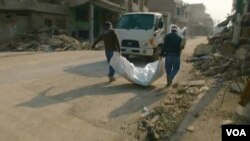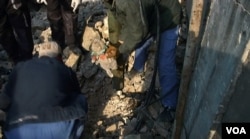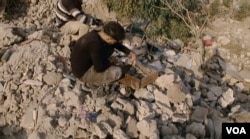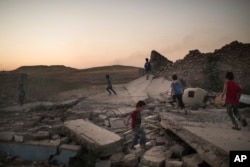Staggering through the endless debris of destroyed buildings with difficulty, Faris Abbas and other workers of Mosul municipality are on a duty to pull out corpses from under the rubble of the Old City in Mosul.
The team first heads to a house where residents have reported a little girl was found.
"Pull gently, brothers, gently," Abbas shouts to rescue workers as they desperately try to remove the charred ruins covering a small body, mostly decomposed and covered with dust. "Here is her stuffed toy," Abbas shouts.
After several minutes of rigorous yet cautious efforts, the mummified body of a little child, grime covering her hair, is pulled from the rubble. Lying next to her is a dusty white stuffed bunny with blue spectacles and a red sweater.
The workers and residents say the victim is a girl, less than 10 years old, killed during the battle for the Old City of Mosul, which ended last July.
WATCH: The search for bodies continues
"Residents of this area informed us about her," Abbas tells VOA as other rescue workers put the child's body in a white plastic body bag. "God bless them."
Nobody knows who she is or whether her parents are still alive. Rescue workers hope the toy will help any family, if they are still alive, identify the body.
Hudaifa Abdulqadir, a Mosul resident, said he informed officials after he spotted the body in the wreckage.
"I have seen the body of this little girl buried here for about one or two months. Even her toy was next to her," Abdulqadir said. "The team of municipality, may God reward their good deeds a thousand times, came and took her."
Islamic State parents
He said he believes the girl most likely belongs to IS parents since no one has listed her as missing.
"But it is also possible that her family were civilians killed due to the battle," he added.
Mosul, Iraq's second-largest city and home to more than 1 million people, came under IS control in mid-2014. Months of IS occupation and the Iraqi battle to oust the terror group left thousands dead and reduced much of the city's western side to rubble.
An Associated Press investigation last month claimed that between 9,000 and 11,000 people were killed in the nine-month battle for the city. Of that number, 3,200 civilian deaths were believed caused by airstrikes and artillery fire from Iraqi government forces and the U.S.-led coalition, according to the report.
However, the Iraqi government and the coalition do not confirm this death toll.
Iraqi Prime Minister Haider al-Abadi said 1,260 civilians were killed in fighting. The U.S.-led coalition, which has not released a death toll, claimed responsibility for 326 of the civilian deaths in the Mosul fighting.
10 to 15 bodies a day
Mosul officials say they have been excavating 10 to 15 corpses a day from under the mounds of rubble since July 2017.
Abbas, head of the Mosul municipality rescue team, said workers have recovered more than 2,500 bodies so far, and he said many more bodies remain buried.
"I never imagined myself becoming a gravedigger," Abbas said from behind the mask he was wearing to protect himself from the stench of the decaying bodies.
Abbas said his team gives priority to finding those sought by their families. Residents have submitted reports of about 3,000 missing family members.
"Many people can't wait for the government and do the digging themselves," he said.
As soon as the body of the unidentified girl is secured in a white plastic bag and placed on the back of a truck with several other recovered bodies, Abbas and the rest of the team take their shovels and head to the next destination. They have been asked by a family to help find their grandfather, Abdulla Husain.
Husain was an 80-year-old sculptor living by himself in an old house made of mud and rocks. His family left Mosul for Iraqi Kurdistan in mid-2014 when IS controlled the city. But Husain refused to leave his home and art pieces behind.
For months through the IS rule, the neighboring family of Mahmoud Yasin provided Husain with food and informed his family about his situation. But Yasin's family, too, fled in June 2017, when the Iraqi forces and the U.S. warplanes increased their attacks against IS in the Old City.
The Old City used to be a densely populated district and Mosul's trade center before the IS occupation.
The ancient city was built during the Ottoman Empire and included the eight-century-old al-Nouri mosque, where IS leader Abu Bakr al-Baghdadi declared IS's caliphate in 2014.
An assessment last year by the U.N. Human Settlements Program estimated 5,390 of the 8,400 housing sites destroyed or severely damaged in Mosul were located in the Old City.
Civilians as human shields
The U.S.-led coalition and the Iraqi forces said IS trapped thousands of civilians in the complex maze of the district to use them as human shields.
"We fled because of airstrikes and rocket fire," Yasin said while recalling the day when he had to flee with his family and leave Husain behind. "This man was unable to flee because he was old."
Yasin told VOA he returned to the city only to help find Husain's body in the rubble.
"There was no way for us to know that he has been killed. He lived most of his life alone in this house," Yasin added.









